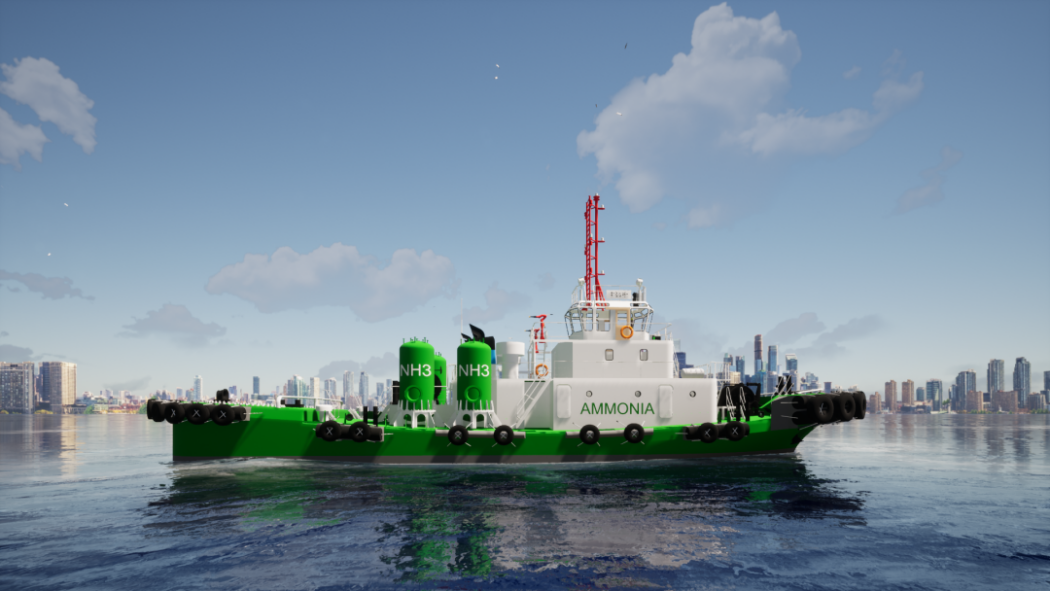
Despite all the ups and downs in the energy market, the trend towards alternative fuels in shipping is firm. Among the most promising types of fuel for the future shipping is ammonia. What has been done for the development of the related technologies and infrastructure since the beginning of 2022?
Ammonia is still considered as one of the most promising marine fuels on the long-term horizon. According to the forecast of DNV, ammonia is to become the prevailing marine fuel after 2040.
However, at first it will be most likely used as a marine fuel on ships carrying ammonia as cargo.
ABS has granted approval in principle (AIP) to Hyundai Heavy Industries (HHI) and Hyundai Mipo Dockyard (HMD) for the concept design of two ammonia-fueled liquefied petroleum gas (LPG) carriers.
Earlier, the Korean Register (KR) awarded approval in principal (AIP) to two green ammonia-fueled ships at KR’s Seoul branch office on 15th December. One of the ships is a 60,000m3 ammonia-fueled ammonia carrier and the other is a 38,000m3 ammonia carrier/bunkering ship, developed by Korea Shipbuilding & Offshore Engineering (KSOE), Hyundai Heavy Industries (HHI) and Hyundai Mipo Dockyard (HMD).
The 60,000m3 ammonia-fueled carrier is currently the largest ship that can be docked at Korean ports.

As for ships intended for transportation of ammonia as cargo, the progress is underway as well. Japanese classification society ClassNK has issued an Approval in Principle (AiP) for the design of an ammonia-ready LNG-fueled Panamax bulk carrier developed by Planning and Design Center for Greener Ships (GSC). For the design developed by GSC, ClassNK reviewed the ammonia treatment measures, piping diagram of the fuel supply system, identification of hazardous area taking into account the flammability and toxicity of ammonia, and evacuation routes in case of emergency in line with the Guidelines.
From the practical point of view, it is interesting to build ‘ammonia prepared’ vessels. Bureau Veritas (BV) awarded ‘ammonia prepared’ notation two 40,000 cbm LPG carriers Geogas under construction at Hyundai Mipo Dockyard (HMD) in the Republic of Korea. The first delivery will be in June 2023.
The new notation: Ammonia-Prepared is applicable to newbuildings, and was developed to support ship owners, designers, shipyards and charterers. Ammonia-Prepared certifies that a ship has been designed and constructed to be converted at a later date to use ammonia as fuel.
The notation targets the spaces and structural components that will accommodate future ammonia fuel tanks, fuel handling equipment and ammonia vapor treatment installations. Ammonia-Prepared also covers specific requirements for the conversion of engines and boilers from using fuel oil, LNG or multiple fuels to ammonia.
Mark Etcheberry, General Director at Geogas, said: “LPG carriers are frequently used to carry ammonia. From a technical point of view this makes the design suitable to be prepared to burn ammonia as a fuel. At Geogas we are committed in our ESG objectives to promote greener propulsion technologies that are technically feasible. LPG, LNG and ammonia gas fuels support these objectives.”

Infrastructure and regulatory framework
Special infrastructure is needed for bunkering ships with ammonia. The facilities to be built include shore-based storage tank farms and specialized bunkering tankers. Besides, regulatory framework is to be developed.
In this context it should be noted that DNV has been selected to lead an ammonia bunkering safety study by the Global Centre for Maritime Decarbonisation (GCMD) in Singapore.
The pioneering study aims to define a robust set of safety guidelines and operational envelopes that will establish the basis of a regulatory sandbox for ammonia bunkering trials at two local sites. To that end, DNV will team up with Singapore’s leading infrastructure developer Surbana Jurong and the Singapore Maritime Academy (SMA).
Besides, Port Authority of Singapore ('MPA') joined the Consortium, consisting of A.P. Moller - Maersk A/S, Fleet Management Limited, Keppel Offshore & Marine, Maersk Mc-Kinney Moller Center for Zero Carbon Shipping, Sumitomo Corporation and American Bureau of Shipping. In May 2022, the Consortium signed a memorandum of understanding with 'K' LINE and MPA to develop the ammonia bunkering ecosystem at the Port of Singapore.
ABS also granted an approval in principle for the concept design of the future bunkering ship.
This follows a feasibility study jointly launched by the Consortium in March 2021 to develop an ammonia bunker supply chain in Singapore. In the past year, the Consortium identified potential ammonia supply sources and indicative costs, as well as undertook the preliminary design and cost estimation for critical infrastructure, such as ammonia storage tanks and bunkering vessels. The Consortium is set to commence ammonia bunkering by 2030.
In summer 2022, the Maritime and Port Authority of Singapore (MPA) and the Port of Rotterdam signed a memorandum of understanding (MoU) to establish the world’s longest Green and Digital Corridor to enable low and zero carbon shipping.
An interesting development is the construction of floating facilities. In August, NYK Line, Nihon Shipyard Co., Ltd. (NSY), ClassNK, and IHI Corporation (IHI) signed a joint research and development agreement for the commercialization of an ammonia floating storage and regasification barge (A-FSRB). Specifically, the parties will work on the R&D of the world's first barge equipped with a floating storage and regasification facility for ammonia.
An A-FSRB is an offshore floating facility that can receive and store ammonia that has been transported via ship as a liquid, warm and regasify ammonia according to demand, and then send it to a pipeline onshore. An A-FSRB offers the advantages of shorter construction time and lower costs in comparison to construction of onshore storage tanks and regasification plants. In fact, the A-FSRB is expected to speed up the adoption of ammonia fuel and contribute to its wider use as a lower-environmental-impact next-generation fuel.
Nevertheless, ammonia is not a panacea and even its use as the main type of ship fuel in the future is not a fact. Among the disadvantages of ammonia are its low power intensity (one fourth of heavy fuel oil’s power intensity) and Nox emissions. Economically, the transition of the shipping to ammonia will require enormous investments in technologies, ship systems and infrastructure.
The prospects of LNG-powered shipping and other alternative fuels will be in the focus of experts and market players at the 6th conference “LNG Fleet, LNG Bunkering and Alternatives” which is to be held by PortNews Media Group on 2 November 2022 in Moscow. The work on the programme is underway – proposals and suggestions are welcome. Visit the Conference page >>>>
More industry-related content is available on our social media pages: YouTube, Telegram, Yandex Zen




